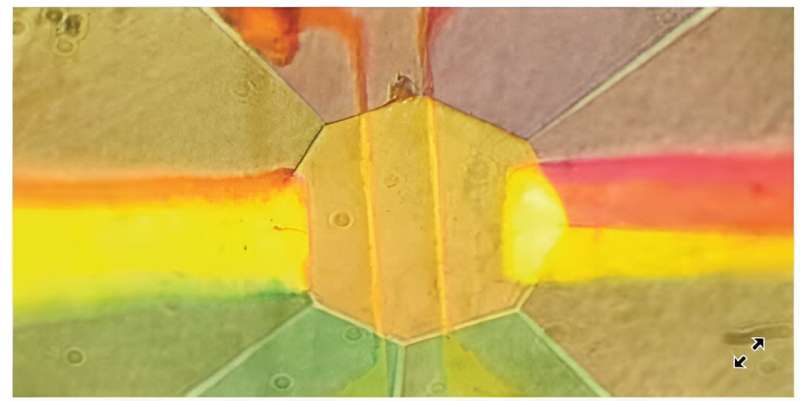July 31, 2024 feature
This article has been reviewed according to Science X's editorial process and policies. Editors have highlighted the following attributes while ensuring the content's credibility:
fact-checked
peer-reviewed publication
trusted source
proofread
New technique measures superconductivity at very high pressures

In 1911, Heike Kamerlingh Onnes discovered the first superconductor, metallic mercury when cooled to a critical temperature of 4.2 Kelvin, where it conducts electricity without resistance. Ever since materials scientists have been on a quest to better understand the phenomenon and whether other elements and materials have higher critical temperatures that could make them useful for practical electricity transport, with the holy grail being ambient temperature.
Many chemical elements become superconducting when exposed to high pressure, below a certain critical temperature. But the details are difficult to measure due to the nature of the high pressure itself.
But now a team of scientists from Germany and the US have developed a technique to make measurements of superconducting sulfur, providing insights into the mechanisms of novel superconductors at high pressure. The work is published in the journal Physical Review Letters. Other materials await investigation.
At pressures greater than 90 billion Pascals—a gigapascal (GPa), almost a million times the atmospheric pressure at Earth's surface—the element sulfur changes from a nonmetal to behaving like a metal. Then, at low temperatures, it becomes superconducting. In the current study, a pressure of 160 GPa was applied, and at 17 Kelvin sulfur's electrons pair up into what are called Cooper pairs, and the superconducting state persists below this temperature.
To obtain pressures of about 3 GPa, scientists have used pistons or Bridgman anvil pressure cells. Pressure cells are sensors that convert pressure into measurable electrical signals. They have the ability to apply pressure uniformly to a sample over a wide pressure range.
The sample is then studied with a planar tunnel junction loaded into the pressure cell, an electronic device that relies on quantum mechanical tunneling where an applied voltage allows electrons to tunnel across an insulating barrier between two conductors.
To obtain higher pressures, the research team used a diamond anvil cell; a pair of opposing diamond tips with a sample between them. The diamond anvil cell can apply pressures up to 200 GPa on samples smaller than a millimeter in size.
The shape of the sample—really the energy levels of electrons on the atom—is then measured by tunneling spectroscopy. However, extreme pressure affects the properties and integrity of the tunneling barrier in the planar tunneling junction, and the device suffers leaked currents and a reduction in the size of the potential energy barrier. It is also difficult to apply to micrometer-sized samples.
To fix these deficiencies, the research team developed a way to fabricate a planar tunnel junction in situ of the diamond anvil cell, that is, in the place where it resides. This allowed measurements above 1 megabar (100 GPa).
The planar tunnel junction's tunneling gap was made of an insulating material, tantalum pentoxide, placed between two conductors—superconducting sulfur and tantalum, and was roughly 50 micrometers across in each dimension. The tantalum pentoxide had a high density and stability and ensured the width of the tunneling gap wouldn't change under high pressures.
"Pressure allows some materials to exhibit exotic properties that do not exit at atmospheric conditions, for example, near room temperature superconductivity in hydrides," said Feng Du from the Max Planck Institute for Chemistry, in Mainz, Germany. "What we are trying to do in this paper is to develop a 'microscope' for superconductivity in a pressurized environment."
Their goal was to measure the superconducting gap of superconducting sulfur, which is also called the cleaving energy, which has been difficult to measure at high pressures up to now. The size and symmetry of this gap, which is an energy gap in the Cooper pair energy density near the Fermi energy, the highest occupied electron energy at absolute zero, is strongly related to the nature of the superconducting mechanism in a material.
The in situ fabrication of the planar tunnel junctions directly on the diamond anvil tip enabled an extension of tunneling spectroscopy measurements to pressures beyond the 100 GPa range.
Tunneling spectroscopy uses a scanning tunneling microscope to scrutinize the local density of electronic states and measure band gap of surfaces at the atomic scale by measuring current flows between the device's tip as it scans across the sample.
With this device, the group measured and confirmed sulfur's critical temperature of 17 K, then lower to about 3 K, and determined sulfur is a type II superconductor.
The group now wants to apply their device to other materials. "This microscope can help us to discover the 'gene' of high-temperature superconductors at high pressure," Du said, "which can potentially help us design the room-temperature superconductor at atmospheric conditions in the future."
They hope to investigate more exotic materials that are less understood, such as hydrides and nickelates.
More information: F. Du et al, Tunneling Spectroscopy at Megabar Pressures: Determination of the Superconducting Gap in Sulfur, Physical Review Letters (2024). DOI: 10.1103/PhysRevLett.133.036002
Journal information: Physical Review Letters
© 2024 Science X Network




















